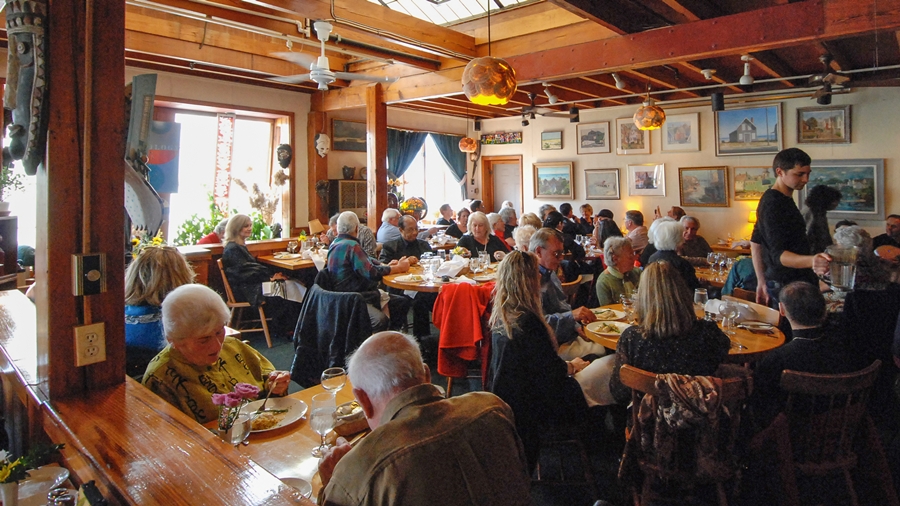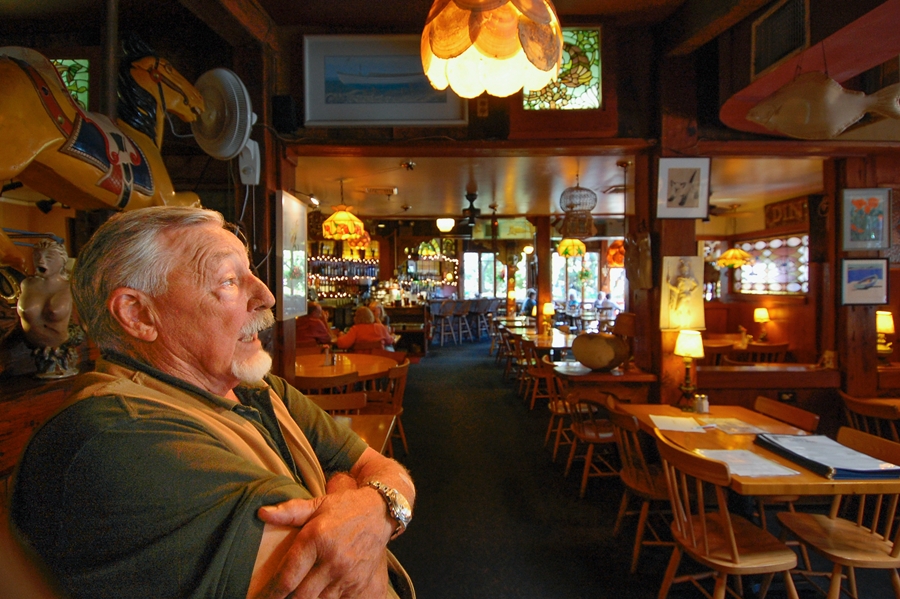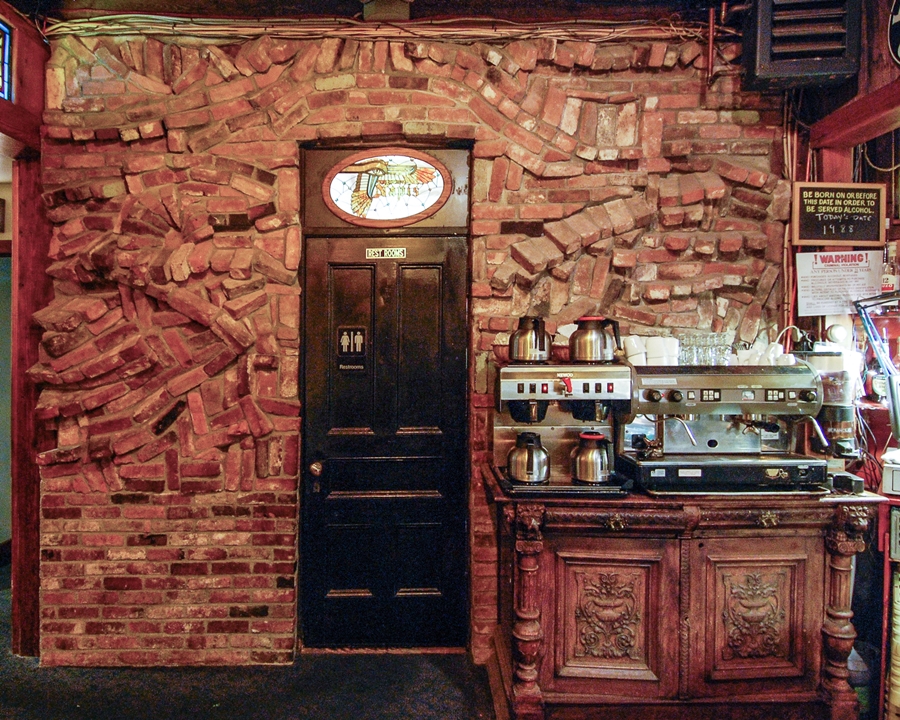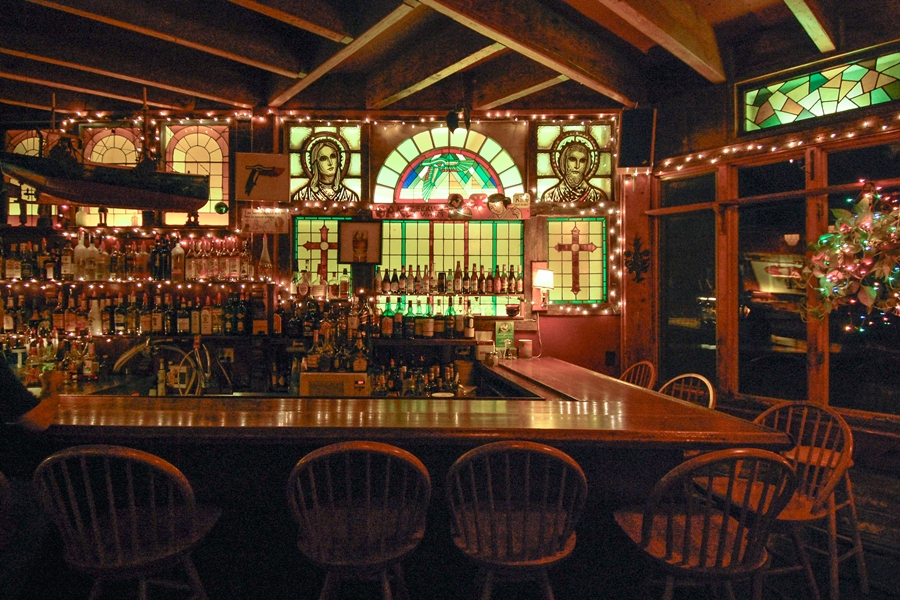PROVINCETOWN — Just shy of its 50th anniversary serving sustenance and spectacle, the eclectic Napi’s, often referred to lovingly as “Provincetown’s most unusual restaurant,” closed its doors last month. Best known for its decor and its late proprietor, Anton “Napi” Van Dereck Haunstrup, the restaurant was for decades a locus of year-round community and a showcase of the town’s artistic heritage.

Napi died on Christmas Day 2019, and the restaurant’s current owner, Dan Sabuda, did not respond to inquiries about the closure from the Independent. But current and past employees of the restaurant confirmed that it has closed for good.
Lisa Martin, who works for the Van Dereck Trust, which controls the many residential properties that Napi also owned, told the Independent in a brief phone call that the restaurant closed because of town enforcement actions at those properties. She would not comment on whether the restaurant has been sold or if there are plans to sell it.
The property is not publicly listed for sale, and there are no public records indicating a transfer of the property or the licenses for the restaurant business.
Martin also blamed the restaurant’s closure on the Provincetown Independent’s reporting on the disposition of Van Dereck’s estate, which is controlled by Bernard McEneaney, a sole trustee who is also the sole conservator for Napi’s wife, Helen Haunstrup, who has dementia.
“We were dragged through the mud, and it ruined the reputation of the restaurant,” Martin said.
Napi and Helen purchased the property at 7 Freeman St. in 1973, when it consisted of a house and a series of moldering garages. At first, the garages served as a flea market for the couple’s burgeoning antique collection. They then had the idea to turn the garages into a Middle Eastern restaurant, a nod to Napi’s trips to Egypt and Palestine as a kid. Two years later, on June 27, 1975, Napi’s Restaurant opened its doors.
According to David W. Dunlap’s architectural compendium Building Provincetown, there was no money to be had from the bank, so Napi relied on his friends for help. A bevy of carpenters, artisans, and artists produced a decor that Dunlap describes as “imaginative, free-flowing, aesthetic, resourceful, somewhat ornery, more than a little bit eccentric and deeply rooted in the town.”
Jackson Lambert embellished a cold air duct hanging from the ceiling of the restaurant with a whimsical arctic tableau and also designed the Eye of Horus emblem that became the restaurant’s logo. Frank Milby built the topographic codfish that hangs over the entrance to the restaurant. And perhaps most notably, the sculptor and mason Conrad Malicoat built one of his earliest “brick breakthrough” designs around the entrance to the restroom.
Dunlap’s inventory of Malicoat’s iconic brick installations lists 14 private homes, Napi’s Restaurant, and the fireplace at the Red Inn. Malicoat’s daughter Galen Malicoat told the Independent she believes the wall at Napi’s was one of Conrad’s first pieces.
“Napi and Helen were so supportive of the arts in so many ways,” Malicoat said. “It gave Conrad a chance to experiment with his art.”

As Napi’s Restaurant rose to prominence, Napi and Helen purchased more than a dozen residential properties to house their employees and amassed a sizable collection of locally made art. “Between the art collection and the real estate, Napi owned half of Provincetown,” said artist Sophia Reznick, an alumna of the Cape Cod School of Art who frequented the restaurant.
Artist Arthur Egeli was a 19-year-old student at Cape Cod School of Art when he first visited the restaurant for an art show upstairs. “I soon realized that Napi was one of the ambassadors of Provincetown art,” Egeli said. “The fact that he was collecting it that early, buying it all over the country and bringing it back to Provincetown, it was almost like he was ahead of the momentum to rediscover our heritage.”
Napi’s became as much museum as restaurant, which meant that the servers were also docents. “We all learned the lore behind the art,” said David Gips, who was a host at Napi’s for almost 30 seasons. “If somebody asked, ‘Who painted that?,’ we had to know. It made it into not just a restaurant but a story people would tell.”
Different patrons were drawn to different artifacts, Gips said. One night, a man came in and spent the whole evening staring at a carousel horse perched along the wall. “Finally, I went over to him and said, ‘Amazing, isn’t it?’ — and he goes, ‘Let me tell you! I might be the only one left in the world, but my job is to repair carousel horses.’ ”
The restaurant later received a letter from that man detailing the make of the horse and its origin, Gips said.
Gips came to Napi’s in 1996 because he heard waiting tables was good money. He met Van Dereck for the first time during his job interview.
“He proceeded to interrogate me on anything and everything but nothing that had anything to do with the restaurant or my experience,” Gips said. “That was good, because I had no experience.” Napi gave him the job because they both had sisters in the Air Force, Gips said.
Gips moved into the residential complex at 25 Bradford St., nicknamed “Napiville,” in the early 2000s. The first unit he moved into had been occupied by dory fisherman Eddie Ritter, and “you could scratch the nicotine off the windowsills,” he said. Gips moved into another unit soon after, which also had some quirks, but it was all right because Van Dereck said he didn’t have to pay rent.
“He said, ‘I have a proposal for you,’ which he had a lot of over the years,” Gips said.

“I would like you to get on your bicycle and go around town and deliver Napi’s menus and chitchat with people,” Gips recalled Van Dereck saying. “In exchange, you don’t have to pay rent.”
Van Dereck was loyal to his workers, and many, like Gips, stayed on for decades. “We were like a small, dysfunctional family,” Gips said. “I made most of my really good friends in Provincetown from that place.”
When Napi died in 2019, he left his fortune, estimated at $17 million, to Helen — but she had already been diagnosed with dementia. She was declared unfit to manage the estate by a judge in Barnstable Probate Court in 2020, and McEneaney won legal guardianship over Haunstrup in 2021.
Ownership of the restaurant passed to Sabuda, who fired many of Napi’s long-term employees in spring and summer of 2021, with at least three families then being told to vacate the housing Napi had owned.
The town received reports of housing code violations at some of the properties, and after years of wrangling with town officials, McEneaney asked the remaining tenants at Napiville to leave in January so he could sell it. In August, an LLC incorporated in Delaware bought the property at 25-27 Bradford St., and while many tenants have remained, others, including Gips, moved out after receiving the January eviction notice.

In the eviction notice, McEneaney wrote that the town’s enforcement actions had forced him to sell; Martin cited similar reasons for the closure of the restaurant.
It is unclear what will happen to what is left of the restaurant. Some art pieces have already gone to the Provincetown Art Association and Museum, which has more than 300 works from Van Dereck’s collection on extended loan, said museum trustee Jim Bakker.
The rest of the restaurant’s artwork will go to auction, Bakker said; 39 pieces were auctioned on Oct. 19. Earnings will “go to Helen for her care,” Bakker said.
Because little is known about the future of the building, the fate of its permanent features are also unknown. “We would be very sad to see the wall come down,” Galen Malicoat said, referring to Conrad’s brick sculpture. “It is part of the artistic legacy of Provincetown that is changing so much.”
“I remember going there in the middle of a snowstorm to have my bouillabaisse,” Reznick said. “Napi would tell me stories as he drank his gin martini at the end of the bar. It was somewhere you could go to get a piece of Provincetown history.”
In his account in Building Provincetown, Dunlap called the restaurant “one of those institutions so interwoven with town life that it would be hard to imagine Provincetown without it.”
Editor’s note: An earlier version of this article, published in print on Oct. 24, incorrectly referred to Galen Malicoat as Conrad Malicoat’s granddaughter. She is his daughter.



